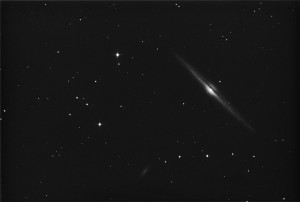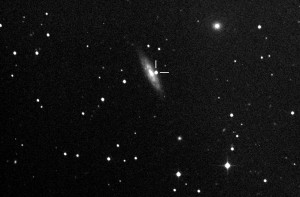Coma Berenices is one of the few constellations that is named for an actual historical figure. The story goes that after King Ptolemy of Egypt ( 246-221 BC ) left for battle, his new wife pledged to the goddess Aphrodite that she would cut off her long blonde hair as a sacrifice if he came home safe. As word came that he was returning, she cut off her hair and placed the locks in Aphrodite’s temple. The next day they were gone. Once the King returned and saw that his wife had cut her hair he was furious, but the court astronomer/astrologer announced that the offering had so pleased the goddess that she had taken the hair and placed it in the sky for all to see.
Although the constellation Coma Berenices is rather small it is home to 8 Messier objects and a sizeable chunk of the Virgo cluster of galaxies. It also has its own much more distant cluster of galaxies. However, the galaxy in this image is not a member of either of those groups. This is the ‘Needle Galaxy’ also known as NGC 4565.
”] Conflicting data show the galaxy’s distance is between 20 and 50 million light years away. Its total light is equal to about 3 billion suns. Obvious in the image is the prominent dust lane that runs the length of the disk. This material appears to be a standard feature of spiral galaxies. The Milky Way also has this obscuring dust lane; it is known as ‘The Great Rift’. Also visible in the image is galaxy NGC 4562 at center bottom.
Conflicting data show the galaxy’s distance is between 20 and 50 million light years away. Its total light is equal to about 3 billion suns. Obvious in the image is the prominent dust lane that runs the length of the disk. This material appears to be a standard feature of spiral galaxies. The Milky Way also has this obscuring dust lane; it is known as ‘The Great Rift’. Also visible in the image is galaxy NGC 4562 at center bottom.
This image is a stack of thirty 30 second exposures taken on the night of the 15th of May.
